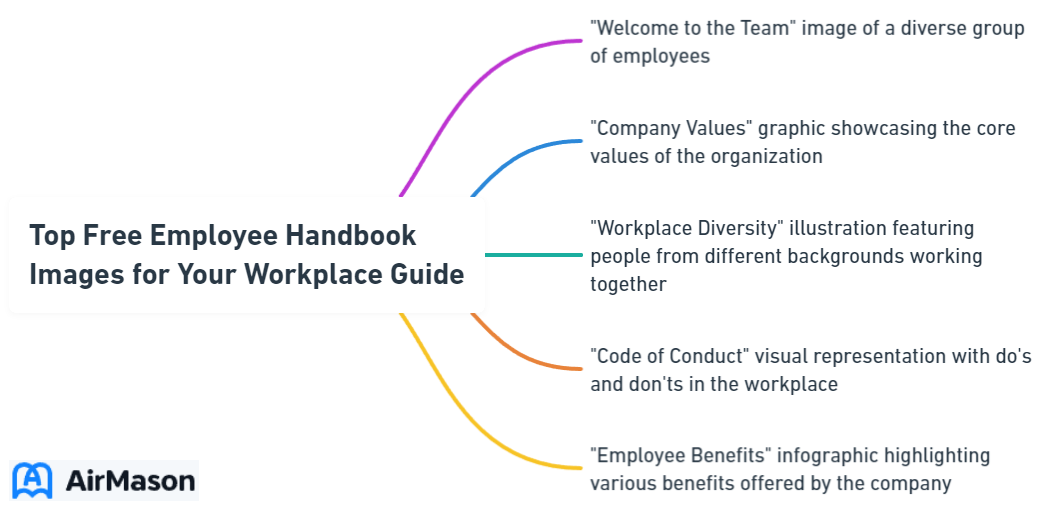
Enhance your employee handbook with images that simplify policies and captivate your staff. This no-fluff guide pinpoints top free resources for high-quality employee handbook images to enrich your workplace guide and foster an inclusive, visually engaging learning experience.
Key Takeaways
- Visual elements such as infographics, diagrams, and custom illustrations in employee handbooks enhance understanding, boost engagement with the content, and help in retaining important information.
- When selecting images for an employee handbook, one should source high-quality, relevant visuals from stock photo websites or company materials, maintain consistency in design, and consider legal aspects of image use including copyright and licensing.
- Incorporating custom illustrations into employee handbooks can reflect the company’s culture and values, and care should be taken to balance visuals with text, ensure image accessibility, and represent diversity to promote an inclusive workplace.
Employee Handbook Benefits
Employee handbook benefits encompass a wide array of advantages for both employees and employers alike. These benefits serve as a comprehensive guide outlining company policies, procedures, and expectations, fostering clarity and consistency across the organization. By providing easy access to important information such as vacation policies, sick leave, and code of conduct, employee handbooks promote transparency and mitigate misunderstandings. Moreover, they can help streamline onboarding processes, ensuring new hires are well-informed from day one. Additionally, employee handbooks often include information about available employee assistance programs, wellness initiatives, and professional development opportunities, demonstrating the organization’s commitment to supporting employee well-being and growth.
The Importance of Visuals in Employee Handbooks

Picture this: you’re a new employee, eager to understand your roles and responsibilities. You’re handed a thick, text-heavy handbook, filled with complex policies and procedures. It feels overwhelming, doesn’t it? Now imagine if that same handbook were spruced up with engaging visuals, diagrams, and infographics. Suddenly, that daunting task of understanding company policies becomes more manageable, even enjoyable. This illustrates the transformative potential of visuals in an employee handbook, turning a mundane document into an engaging guide that employees are motivated to read.
Visuals serve a dual purpose in handbooks – they enhance engagement and improve comprehension. They offer a condensed way to convey vast information, making intricate concepts digestible. Pictures not only add aesthetic appeal to an employee handbook but also significantly enhance its effectiveness.
Moreover, images that reflect the company’s culture and values help to reinforce a sense of identity and belonging among employees.
Enhancing Understanding
Infographics, flowcharts, and diagrams act as visual shortcuts to understanding complex data. They condense and clarify intricate information, making the material more accessible and memorable to employees. Visuals serve as attention grabbers to key information, assisting in the comprehension and recall of crucial policies and procedures.
The inclusion of visuals in employee handbooks accommodates various learning styles, particularly benefiting those who favor visual aids over textual descriptions. Diagrams, such as organizational charts and safety layouts, deliver structured visual information, facilitating an easy understanding of spatial and relational concepts. The use of charts and graphs offers a simplified presentation of statistical data, facilitating rapid comparison and assimilation of large-scale data sets.
Furthermore, custom illustrations and icons can demystify complicated ideas and spotlight essential sections, enriching the learning experience for employees.

Boosting Engagement
Who doesn’t love a good picture book? Visual content interspersed with text offers a more immersive reading experience. It helps break the monotony of large blocks of text, making the handbook more enjoyable. Relevant visuals generate increased interest by engaging both rational and emotional intelligence, thus fostering a deeper connection with the content.
Moreover, custom illustrations tailored to the company’s culture and employees can significantly boost engagement. They create a unique and relatable handbook experience that is not only informative but also reflective of your unique brand identity.
Aiding Retention
Incorporating visuals into learning materials can increase retention by up to 42%. Why? Because visuals engage multiple brain areas, which aids in easier information processing. Remember, our brains process visuals 60,000 times faster than text. This makes visual storytelling a powerful tool for conveying complex ideas and messages.
People are more likely to remember a visual element, such as a picture or graphic, long after reading text. This ensures better information retention. Employee handbooks that combine text and imagery help employees understand and remember policies more effectively. Visuals highlight key information, making vital details more noticeable and memorable.
Finding the Right Images for Your Employee Handbook

With the importance of visuals established, it’s time to delve into the process of selecting appropriate images for your employee handbook. There are several sources for high-quality, cost-effective images that comply with copyright laws. These include:
- Vecteezy
- Freepik
- Morguefile
- Pixabay
- Stockvault
- Pexels
- Picjumbo
- Rawpixel
- Reshot
Before initiating the image collection process, it’s vital to obtain feedback on your handbook’s design and selected images to guarantee clarity of the visual message and alignment with the communication and comprehension goals.
Massachusetts State Employee Handbook
The Massachusetts State Employee Handbook serves as a comprehensive guide for employees regarding their rights, responsibilities, and policies within the state government. This handbook outlines key information such as employee benefits, workplace conduct standards, and grievance procedures. It also provides details on leave policies, including sick leave, vacation time, and holidays. Additionally, the Massachusetts State Employee Handbook highlights important legal regulations and resources available to employees. By adhering to the guidelines outlined in this handbook, both employees and the state government can maintain a fair and productive working environment
Sourcing Images
For image sourcing, contemplate using stock photo websites like:
- Shutterstock
- Unsplash
- Pexels
- Pixabay
- Vecteezy
- Freepik
- Morguefile
- Rawpixel
- Reshot
- Picjumbo
These sites offer extensive libraries of high-quality photos and graphic resources that are suitable for employee handbooks. Most of these free stock photo sites operate under licenses like Creative Commons Zero (CC0), allowing commercial use of images without requiring author consent or separate permissions.
Don’t forget that company events and existing marketing materials can also be leveraged as unique and personal image sources for employee handbooks.
Image Types and Formats
After sourcing your images, ensure to opt for consistent file formats. For instance, JPEG is suitable for photographs, while PNG is preferable for graphics with transparent backgrounds. This ensures compatibility across all handbook pages.
Ensure that your images are of high quality and appropriate resolution, but also consider file size to avoid loading or printing issues. If you’re considering creating custom illustrations, tools like Adobe Illustrator and Canva provide templates and user-friendly interfaces, even for those with minimal design experience.
Consistency in Design
Visual consistency throughout an employee handbook is crucial for enhancing brand recall and reinforcing brand identity. A style guide helps ensure that all images align with the organization’s visual standards, including color schemes, fonts, and layouts.
Keep in mind that regular reviews of the handbook are necessary to rectify any visual discrepancies that may hinder design consistency and clarity.
En beelden te: Incorporating Images into Your Employee Handbook Design
The incorporation of images, or ‘En beelden te’, plays a vital role in the design of an employee handbook. It’s not just about adding pictures randomly. Each image should:
- Symbolize the organization’s values
- Enhance personalization of the handbook
- Aid in retention of company culture
- Convey compliance with policies.
Images should also break up text in the handbook, making the content more engaging and approachable. From infographics and flowcharts to photographs of company events and office spaces, a variety of images should be utilized to support diverse learning styles and create an inclusive resource for all employees.
Placement and Sizing
The strategic placement of images near relevant text provides visual context and aids in understanding the handbook’s content. Equally important is the sizing of images. Large images can be distracting and take up unnecessary space, while small images may not be clearly visible.
Employ captions and annotations alongside images to offer further context and emphasize significant details within the visuals.
Image Accessibility
Your employee handbook should be accessible to all, and this includes the images used. Incorporate alternative text (alt text) descriptions for images to make them accessible to individuals using screen readers or Braille devices. Use descriptive alt text for each image in employee handbooks so that screen reader users can understand the content.
Further, employ the use of high-contrast colors in images to better serve employees with color vision deficiencies. Providing text descriptions alongside complex infographics or charts enables access to information for those who cannot see the visuals.
Balancing Text and Visuals
While visuals are crucial, it’s important to maintain a balance between text and visuals in your employee handbook. Images in a handbook should serve specific purposes such as illustrating complex concepts or emphasizing vital information, rather than being added only for aesthetic reasons.
Illustrations prove to be most effective when designed to encapsulate the key points of policies or sections in the handbook, thereby guaranteeing clear transmission of fundamental messages. A balance between text and visuals in the handbook is essential to prevent overwhelming the reader, with images enhancing rather than distracting from the written content.
Creating Custom Illustrations for Your Employee Handbook

Custom illustrations can infuse a personal touch into your employee handbook while mirroring the company’s brand identity and culture. This provides a sense of belonging and connection for employees.
Tailoring the handbook with illustrations relevant to specific roles or departments can improve comprehension and retention of workplace policies and procedures.
Benefits of Custom Illustrations
Custom images can be decisively crafted to reflect a company’s brand identity, ensuring consistency and familiarity across all company materials, including the employee handbook. Tailor-made visuals in an employee handbook can serve as a powerful tool for emphasizing and embedding the company’s values and mission into the everyday consciousness of its workforce.
Hiring an Illustrator
Engaging a professional illustrator could be a worthwhile investment for generating custom illustrations. Here are some steps to follow when working with an illustrator:
- Review the illustrator’s portfolio to confirm if their style is in line with the company’s branding and the intended message of the employee handbook.
- Clearly communicate the objectives, target audience, and specific illustration requirements to the illustrator.
- Provide feedback and collaborate with the illustrator throughout the process to ensure the images appropriately represent the company’s message.
Always establish clear expectations regarding the deliverables, which includes setting deadlines, agreeing on the number of revisions, and determining the types of illustrations needed.
DIY Illustration Tools
If you’re on a tight budget or want to try your hand at creating illustrations, there are numerous DIY illustration tools available. Illustration tools like Canva and Stencil, known for their user-friendly interfaces, extensive libraries, and templates, simplify the creation of custom visuals, catering to varied skill levels.
Inkscape and GIMP are cost-effective and free illustration tools that offer robust features for vector graphics and image editing useful for employee handbook designs.
Legal Considerations for Using Images in Employee Handbooks
Beyond the creative facets of using images in employee handbooks, it’s imperative to take into account the legal implications. This encompasses comprehension of copyright laws, safeguarding employee privacy, and promoting inclusivity in image selection.
Copyright and Licensing
Securing appropriate permissions or licenses is a must when using images in employee handbooks to prevent copyright infringement. Consulting with a legal team is important to ensure that both the images and the content of an employee handbook are in compliance with legal standards and company policies.
A fair use analysis might be required to evaluate if the use of an image is permissible under the U.S. fair use doctrine.
Protecting Employee Privacy
Though using employee photos might be tempting for a personal touch, privacy laws must be taken into consideration. Many states have ‘right of publicity’ or ‘right of privacy’ laws which necessitate obtaining prior consent from employees.
Employers must review such state laws and secure consent before using employee photos for commercial purposes.
Ensuring Inclusivity
Lastly, let’s talk about inclusivity. The images in employee handbooks should echo the company’s values and portray its diverse workforce and inclusive environment. Inclusive imagery should represent a diverse range of:
- races
- ethnicities
- genders
- ages
- abilities
- body types
This creates a culture where these perspectives are welcomed and valued.
Summary
In conclusion, visuals play a crucial role in enhancing the effectiveness of employee handbooks. They enhance understanding, boost engagement, and aid retention. From sourcing the right images and incorporating them effectively into your handbook to creating custom illustrations and understanding legal considerations, there’s a lot to consider when using images in your handbook. But the effort is worthwhile, given the potential benefits. Remember, a picture is worth a thousand words. So, let your images speak volumes about your company’s culture, values, and commitment to employee engagement and understanding.
Handbook PDF
The Handbook PDF contains all the essential information and guidelines that employees need to know about company policies and procedures. It serves as a valuable resource for new hires to familiarize themselves with the organization’s expectations and standards. Additionally, existing employees can refer to the Handbook PDF for updates and clarifications on various topics such as benefits, leave policies, and code of conduct. By providing this document in a digital format, the company ensures easy access and distribution to all employees. The Handbook PDF is regularly updated to reflect any changes or amendments to company policies, keeping employees informed and compliant with current regulations.
Frequently Asked Questions
Why are visuals important in an employee handbook?
Visuals are important in an employee handbook because they enhance understanding, boost engagement, and aid retention by making complex concepts easier to understand and increasing information retention.
Where can I source images for my employee handbook?
You can source images for your employee handbook from stock photo websites like Shutterstock, Unsplash, Pexels, and company events and existing marketing materials. Using these resources will help you find a variety of high-quality images to enhance your handbook.
What legal considerations should I be aware of when using images in an employee handbook?
When using images in an employee handbook, it’s important to consider copyright laws and obtain proper permissions. Additionally, ensure to protect employee privacy by obtaining consent before using employee photos. Aim for inclusivity by using images that reflect a diverse workforce.
Can I create custom illustrations for my employee handbook?
Yes, you can create custom illustrations for your employee handbook. Consider hiring a professional illustrator or using DIY illustration tools such as Canva, Stencil, Inkscape, and GIMP.
How can I ensure inclusivity when selecting images for my employee handbook?
To ensure inclusivity in your employee handbook, select images that represent a diverse range of races, ethnicities, genders, ages, abilities, and body types, creating a culture where these perspectives are valued.
Important Disclaimer:
Please be aware that the content on this page has been generated by using artificial intelligence language models and may contain errors, inconsistencies, or outdated information. It is provided as-is without any warranties or guarantees of accuracy.
We strongly recommend using this content as a starting point for further research. We disclaim any liability for damages or losses resulting from the use or reliance on this content.